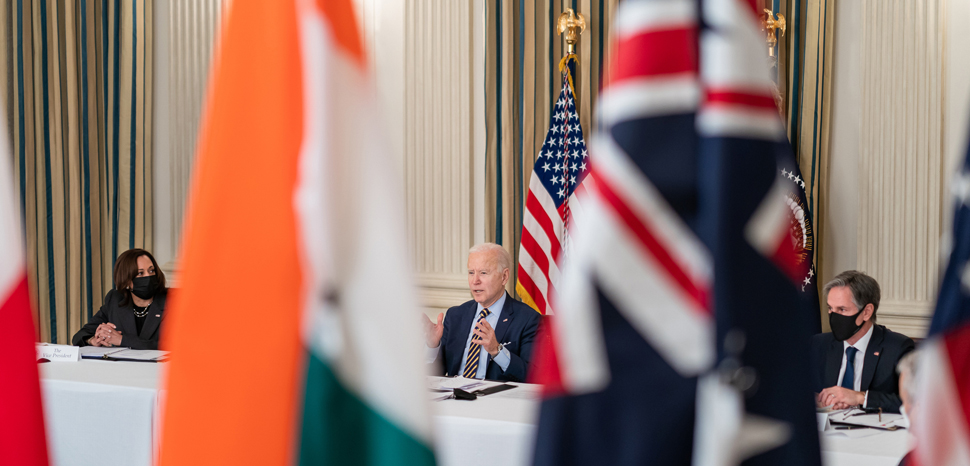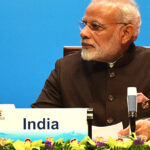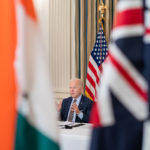
For most of its existence, the Quad has been conceptualized as an informal entity with objectives primarily aimed at containing China and maintaining the long-standing rules-based international order. For India, Japan, Australia, and the United States these interests are firmly rooted in the implementation of a cohesive, salient Indo-Pacific policy. In the early months of the Biden administration, the United States has viewed the Quad as fundamental to its strategy in the region, and the grouping has been engaged in constructive talks between high-level officials, namely US Secretary of State Anthony Blinken and Subrahmanyam Jaishankar, India’s minister of external affairs. These high-level conversations followed a virtual meeting between Quad heads of state and the first visit of US Defense Secretary Lloyd Austin to India. While much of the discussion has been on how its membership can contain growing Chinese influence and aggression in the Indo-Pacific, it can be argued that there is a gradual evolution of the Quad’s agenda.

Part of this evolution came during the virtual Quad meeting held this past March, where members discussed COVID-19 related diplomacy where 1 billion vaccines would be delivered by 2022, which will directly benefit Indo-Pacific countries. Quad leaders also discussed “shared challenges” across the Indo-Pacific domain, such as counterterrorism, strengthening democratic alliances, climate change, cyber security, as well as humanitarian and disaster relief. One of the earliest signs of an expanded Quad mandate was a commitment to the complete denuclearization of North Korea. However, the Quad’s strategy in the Indo-Pacific is not merely restricted to the containment of China nor the promotion of a free and open Indo-Pacific, as there is plenty of other areas of concern, particularly in Central Asia. Continental issues should concern and influence the Quad’s strategic expansion, as each member has direct and indirect national interests in the peaceful transition of power in Afghanistan, particularly after the US troop withdrawal is completed. The withdrawal presents an opportunity to engage Quad partners on Afghan policy and open alternatives to existing mechanisms to the peace process.
All members of the Quad have been fully invested in Afghanistan in the past, as well as for its future. India is already a part of the six-party talks and remains Afghanistan’s largest regional donor in the reconstruction effort, contributing over $3 billion in reconstruction assistance, covering everything from infrastructure to agricultural development. Most notable among India’s contributions is the Afghan-India Friendship Dam, which has a capacity of 42 MW and supplies enough water to irrigate more than 75,000 hectares of land. India has also developed the Chabahar Port with Iran, located in Iran’s Sistan-Baluchistan province, which enhances sea-land connectivity with Afghanistan and the rest of Central Asia.
Japan became one of Afghanistan’s most significant development partners after September 11, 2001, initiating and hosting the Tokyo Conference in 2002, which marked the beginning of the internationally led reconstruction process. At a development conference in Geneva this past November, Japan pledged $720 million for reconstruction over the next four years. Afghanistan still relies on donor assistance for a majority of its national budget and the conference aimed to boost national capacity during the second half of Afghanistan’s “decade of transformation.” Like Japan and India, Australia has also been an active development and reconstruction partner, contributing more than $750 million in development assistance since 2001. Afghanistan and Australia also have a Comprehensive Partnership Agreement as well as a Development Framework Agreement signed in 2012.
Engagement with Afghanistan would likely reestablish channels of bilateral cooperation, as well as open new multilateral channels for the Quad into Central Asia. Continuing bilateral involvement and investment in the reconstruction of Afghanistan will institutionalize and consolidate an existing gamut of intra-grouping bilateral and multilateral relations. Most importantly, the initiative is likely to curb any asymmetrical advantage for China in a post US-led Afghanistan, and will spread the onus between partners of the Quad.
As of now, the peace process in Doha and its likely consequences are stacked against the United States, which has agreed to, and has nearly completed, a military withdrawal from Afghanistan. Naturally, this makes other actors, such as China, Russia, and Pakistan possibly more influential in a more Taliban-centric Afghanistan. China is urging closer security and economic cooperation with Afghanistan in an apparent effort to bolster its influence in the region as the U.S. and its allies prepare to withdraw their forces from the country.
While China does not welcome the presence of US forces in Afghanistan, it does not want the region to become more vulnerable to terrorism either. Beijing has tried to quickly develop trilateral relations with Afghanistan and Pakistan for the expansion of Belt and Road cooperation as well as shore up counterterrorism efforts. Those efforts are somewhat compromised by China’s persecution of Turkic ethnic groups in Western China, of which some, including Uyghur Muslims have begun to radicalize and take up positions within Afghanistan. Pakistan also faces a quandary. There is a strong likelihood of a growing militancy in the border areas and expanding religious extremism, evidenced by transnational militant groups operating along the porous Pakistan-Afghan border. The UN recently warned that Al Qaeda leadership remains in the border areas and maintains ties to certain groups, raising questions about the Taliban’s promise not to allow Afghan soil to be used to launch future terrorist attacks. Pakistan is clearly worried about being caught in the middle of an outbreak of severe violence along its long border.
The Quad’s involvement in Afghanistan could help mitigate security concerns along the border. The Quad cannot afford a new paradigm of Afghan dependence on less stable and more unpredictable actors. It must maintain a process of stable external incentives through Quad partners. What is past should still be prologue. However, the Quad continues to strengthen as it evolves. Afghanistan should not be in just in the peripheral vision of Quad members as its strategic vision evolves. Members need to remain engaged bilaterally and as a group as the Afghanistan transitions into the post-NATO era. Quad engagement in Afghanistan will not just restore the balance of power in the larger Indo-Pacific region, but also fill a critical continental gap in the conception of this regional expanse.
Co-authored with Dr. Vivek Mishra, a Research Fellow at the Indian Council of World Affairs based in New Delhi, India.






